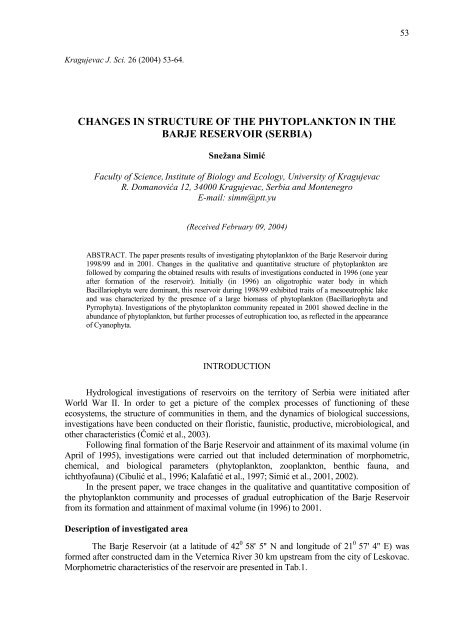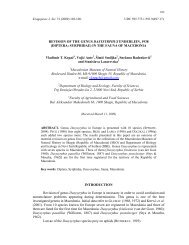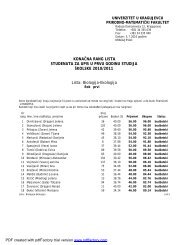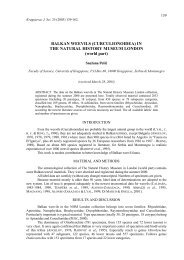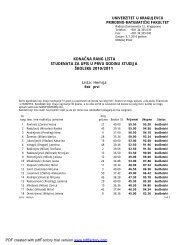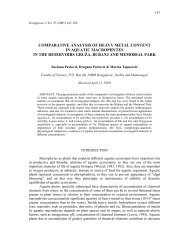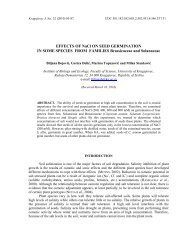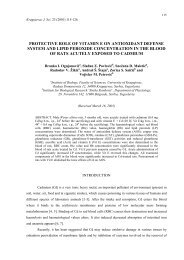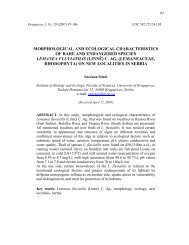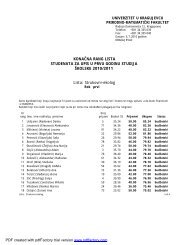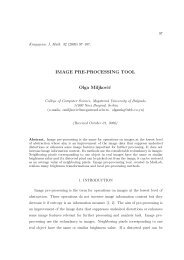Journal - Prirodno-matematiÄki fakultet u Kragujevcu
Journal - Prirodno-matematiÄki fakultet u Kragujevcu
Journal - Prirodno-matematiÄki fakultet u Kragujevcu
Create successful ePaper yourself
Turn your PDF publications into a flip-book with our unique Google optimized e-Paper software.
HTV8BLR-Q,HTV-DDBLR-L/RBi-LevelBarrier-Free Cooler(CONTINUED)ELECTRICALFurnished with plug-in, 3-wire grounding typeservice cord. Standard 120 volt, 60 Hz, singlephase. Install 120-volt receptacle, rated at15-amp minimum, to receive 3-wire parallelblade grounding type male plug.SIDE VIEWHANGER BRACKET18 3/4"476mm3"76mmMOUNTING HEIGHTMounting height recommended 30 1 /4" frombasin to floor. May be mounted at any desiredheight. Check local codes.MOUNTING INSTRUCTIONSMount trap and install service stop to buildingsupply line. Anchor hanger bracket securely towall with six fasteners. To insure proper engagingof waste line into trap, centerline of trap mustbe 7" from wall face. Remove slip nut and gasketfrom trap and install on waste line tube. Hangcooler on bracket and engage waste line tubeinto trap inlet. Centerline height of waste outletwill vary from floor line depending on mountingheight. Connect service stop to solenoid valveusing 3/8" supply tube. Secure bottom of coolerto wall using holes provided.Trap and service stop not included.OPERATING PRESSURES:Supply water - 20 to 105 psi. Minimum 40 psisupply line pressure required in specialcircumstances when both sides of bilevel are inuse simultaneously to ensure adequate streamheight. Does not apply to non-refrigeratedunits.FRONT VIEW / WALL LAYOUT16 1/8"410mmAT WALL33 3/4" (857mm) AT WALL36 1/2" (927mm) OVERALL18"457mm6 3/8"162mm6 3/8"162mm38"965mmORIFICEHEIGHT36 1/4"921mmRIMHEIGHT32"813mmORIFICEHEIGHT30 1/4"768mmRIMHEIGHT*27"686mm9"228mm3" MAX.76mm7"178mm15"381mm* Adult ADA requirement (shown) - 27" (686mm);Child ADA requirement - 24" (608mm).Adjust all other measurements accordingly.NOTE: Halsey Taylor's recommended orificemounting height for children 38" to 46" tall(approx. four through seven years old) is 23"from the finished floor.ALL 6 OF THE 1/4" (6mm) DIA.HOLES SHOULD BE USED TOSECURE BOTH WALL BRACKETS6 3/8"162mm6 3/8"162mm2"51mm33 1/4"845mmD(PREFFERED LOCATION)23 3/4"603mmE22 1/2"572mm2"51mmBF16 1/2"419mm3 3/4"95mmCL14 1/2"369mm6"152mmFINISHED FLOOR3 3/4"95mmCL14 1/2"369mmAFE22 1/2"571mm6"152mmD (ALT. LOCATION)25 3/4"654mm28 1/2"724mmLegend:A = RECOMMENDED WATER SUPPLYLOCATION. SHUT OFF VALVE(NOT FURNISHED) TO ACCEPT3/8" O.D. UNPLATED COPPER TUBE.B = RECOMMENDED LOCATION FORWATER OUTLET 1-1/2" O.D. DRAINC = 1-1/2" TRAP NOT FURNISHEDD = ELECTRICAL SUPPLY (3) WIRERECESSED BOX (DUPLEX REQUIRED)E = INSURE PROPER VENTILATION BYMAINTAINING 6" (152 mm) (MIN.)CLEARANCE FROM CABINETLOUVERS TO WALLF = 5/16" BOLT HOLES FOR FASTENINGUNIT TO WALLPrinted in the U.S.A.
55S=2C/A+B,where A is the number of species present in one population, B is the number of species present inthe other population, and C is the number of species present in both populations. as control weuse Jaccard index (C j ) (Schwerdthfeger, 1975):C j = j/ a+b-jwhere a is the number of species present in one population, b is the number of species present inthe other population, and j is the number of species present in both populations.RESULTS AND DISCUSSIONQualitative analysis of phytoplankton during the period from 1996 to 2001 indicates thepresence of 78 taxa (Tab. 2). Pyrrophyta, Bacillariophyta, Euglenophyta, and Chlorophyta wereconstantly recorded, while Cyanophyta were found only in 1996 and 2001, and Chrysophytaonly in 1996. In all periods of investigation, silicate algae were dominant with respect to thenumber of taxa. In comparing the qualitative composition of phytoplankton during the periods1998/99 and 2001, 25 taxa were found that appeared in both periods. The index of similaritycaluculated according to Sørensen for these periods of investigation likewise indicates greatsimilarity in the qualitative composition of phytoplankton (S = 68%). Significantly lower valuesare obtained when the qualitative composition of phytoplankton is compared for the periods1996 and 1998/99 (19 taxa found in both periods, S = 42,7%); and 1996 and 2001 (20 taxa, S =43,5%). Similar relations were obtained using the Jaccard index (Tab.3).Comparison of the qualitative composition of phytoplankton in the Barje Reservoir andthe number of species found in 1996 (Kalafatić et al., 1997), 1998/99, and 2001 reveals a gradualdecrease in the biodiversity of phytoplankton (Tab. 3). It occurred primarily due to decline in thenumber of species of pennate silicate algae, which were characteristic of the initial investigationsof the reservoir in 1996. These species (originating from the periphyton and benthos of theVeternica River) in the beginning found favorable conditions for survival and development inwater of the Barje Reservoir, thereby indicating the then-existing lower trophic level of thisaquatic ecosystem (Kalafatić et al., 1997; Cibulić et al., 1997). In recent years, the number ofthese species has declined at the expense of true planktonic forms of the group Bacillariophyta,but also as a result of increase in the number of species of Chlorophyta and Cyanophyta (in 2001eutrophic forms of Anabaena and Microcystis appeared which were absent in the reservoir at thetime of the investigations conducted in 1999). Blue-green algae (Chrorococcus sp.,Merismopedia sp., Anabaena sp., and Spirulina sp.) were only sporodically present during thefirst year after formation of the reservoir (Kalafatić et al., 1997).Especially noticeable are changes in the ratio of abundance of certain species recorded inthe phytoplankton of the Barje Reservoir from its formation to 2001.Phytoplankton of the Barje Reservoir in 1996 was characterized by relatively low values ofpopulation abundance. Absolute abundance at different sites fluctuated as follows: 0-53000 ind/lat the D site (next to the dam); 4000-254000 ind/l at the C site (in dthe middle of the lake); and179000-3738,000 ind/l at the M site (where the Veternica River empties). These values point to alow trophic level of the ecosystem. With one exception (the surface layers of water at the M sitein September), Bacillariophyta were dominant at all sites throughout the year, with representati-
56Tab. 2. Floristic composition of phytoplankton of Barje ReservoirTaxa1996(Kalafatićet al.,1997)1998/992001CyanophytaAnabaena sp. + - +Chroococcus limneticus Lemm. + -Merismopedia sp. + -Mycrocistis aeruginosa Kütz. - - +Oscillatoria sp. - - +Spirulina sp. + -PyrrophytaCeratium hirudinella (O. F. M.) Schrank + + +Glenodinium sp. + - -Gymnodinium palustre Schilling + + +Peridinium bipes Stein + - -Peridinium incoscopicuum Lemm. + + +Peridinium pusillum (Pénard) Lemm. + - -Peridinium willei Huif.-Kass - + +ChrysophytaDinobryon sp. +BacillariophytaAchnanthes minutissima Kütz. + - -Amphora ovalis Kütz. + + +Asterionella formosa Hass. + + +Cocconeis pediculus Ehr. + - +Cocconeis placentula Ehr. + - -Cyclotela glomerata Kütz. + + +Cyclotella comensis Kütz. + + +Cymatopleura elliptica (Breb.) W. Sm. - + +Cymatopleura solea (Breb.) W. Sm. + + +Cymbella affinis Kütz. - + +Cymbella lanceolata (Ehr.) Kirch. - + -Cymbella naviculiformis (Auers.)Cl. + - -Diatoma elongatum (Lyngb.) Ag. - + -Diatoma vulgaris Bory + + +Fragilaria crotonensis Kitton + + +Fragilaria ulna (Nitz.) L.-B. Sippen acus sensuKrammer & L.-B. (= Synedra acus Kütz.)+ - +Fragilaria ulna (Nitz.) Lang.-Bert. ((= Synedraulna (Nitz.) Ehr))+ + +Gomphonema olivaceum (Horn.) Breb. + - -Gyrosigma sp. + + +Melosira granulata v. angustissima (Müll.) Hust. + - +Melosira varians Ag. + + +Navicula cuspidata (Kütz.) Kütz. - - +Tab. 2. Continued
57Navicula pupula Kütz. + - -Navicula sp. - - +Navicula tripunctata (O. F. Mull) Bory + + +Nitzschia acicularis W. Sm. + - -Nitzschia palea (Kütz.) W. Sm. + - -Nitzschia radiosa Kütz. + - -Nitzschia sigmoidea (Nitzsch.) W.Sm. + + +Nitzschia viridula Kütz. (Ehr.) + - -Nitzschia. vermicularis (Kütz.) Grun. + - -Pinnularia sp. + + -Rhoicosphaenia abbreviata (C. Ag.) Lang.- Bert. + + -Rhopalodia gibba (Ehr.) Müll. + - -Surirella minuta Bréb and Kütz. (=S. ovata-Kütz.)+ -Surirella capronii Bréb - + +Surirella sp. +EuglenophytaEuglena sp. - - +Lepocinclis sp. +Phacus caudatus Hübn. +Trachelomonas hispida (Perty) Stein em Defl. +Trachelomonas oblonga Lemm. +Trachelomonas volvocina Ehr. + + +ChlorophytaChlamidomonas sp. - + -Closterium parvulum Näg. - + +Coelastrum microporum Näg. - - +Coenochloris pyrenoidosa Korš. - + -Coenococcus planctonicus Korš. - + -Cosmarium sp. - - +Eudorina elegans Ehr. + + +Gonium pectorale Müller +Pandorina morum (O. F. Müller) Bory + - -Pediastrum duplex Meyen - + +Pediastrum simplex Meyen - + +Scenedesmus alternans Reinsch + - -Scenedesmus bicaudatus (Hansg.) Chod. + - -Scenedesmus ecornis (Ralfs) Chod. + - -Scenedesmus quadricauda (Turp.) Bréb - + +Scenedesmus tenuispina Chod. + - -Sphaerocystis schroeteri Chod. - + -Spirogyra sp. - - +Staurastrum sp. - +Tetraëdron minimum (A. Br.) Hansg. + - -Ulothrix zonata (Web. et Mohr) Kütz + - -Volvox aureus Ehr. - - +Total of number taxa 54 35 38
composition and succession of the phytoplankton community on the one hand and prevailingvalues of the indicated factors on the other. Biotic factors also exert significant influence onchanges in the phytoplankton community (Reynolds, 1984; Sommer, 1989; Olden, 2000).Characterized by the absence of a zone with dominant plants in the littoral, the BarjeReservoir consequently represents an unstructured habitat with a simple linear food chain:nutrients-phytoplankton-zooplankton-fish (Scharf, 1999). The effect of zooplankton on thephytoplankton community is very significant in determining the succession of phytoplankton(Sommer, 1989; Olden, 2000). The greatest visible influence stems from utilization ofphytoplankton as food by zooplankton, which directly results in reduction of the mass ofphytoplankton (Lambert et al., 1986; Sterner, 1989). The composition of zooplankton is also ofpotential influence (Bergquist et al., 1985). It is generally held that mesoplankters (for exampledaphnias of the group Cladocera) exert greater influence on phytoplankton biomass than dosmall species (Copepoda) (Hall et al., 1976; Lynch & Shapiro, 1981). Also, phytoplankton canmanifest a certain resistance to being consumed as food, which is a consequence ofmorphological differentiation in regard to cell size and shape, possession of hard shells, or thepresence of gelatinose coatings (De Bernard & Guissan, 1990).According to the data Kalafatić et al. (1997), zooplankton of the Barje Reservoir in 1996was characterized by low abundance (from 2 to 6821 ind/l). Protozoa, Rotatoria, Cladocera, andCopepoda were present. Maximal values were recorded in surface layers of water in the middleof the reservoir in May (2473 ind/l) and around the M of the Veternica River in September (6821ind/l). Minimal abundance of zooplanktonic organisms was recorded in layers of water next tothe bottom.The data of Simić et al. (2002) indicate that zooplankton during 1998/99 was characterizedby the presence of taxa of the groups mentioned, but also by significantly greater abundance(from 273 to 37000 ind/l). The lowest density of zooplankton occurred in the fall, while densitiesduring the spring and summer were considerably higher. During the autumn period, Copepodaand Rotatoria were the most abundant. Rotatoria were the most abundant in the late springperiod, while in summer large species of Copepoda and Cladocera were the most abundant, andRotatoria were dominant only in the shallowest part of the lake. The increased abundance ofzooplankton constituted a good trophic base for planktivorous species of fish and fish fry (Simićet al., 2002).According to the data of Simić et al. (2002), zooplankton in 2001 was not much changed inthe qualitative sense, but significantly altered in the quantitative sense. A general decrease inoverall density of zooplankton was evident in relation to 1998/99 (absolute abundance fluctuatedfrom 500 to 15,900 ind/l), but also significantly increased abundance of zooplanktonic formsfrom the group Cladocera, above all the eutrophic species Bosmina longirostris Müller duringthe summer period (August). Increase in the density of Cladocera--which have beencharacterized as mesoplankters and more capable feeders (Olden, 2000)--during this periodunquestionably affected decline in the density of edible groups of phytoplankton and madepossible dominance of the alga Anabaena sp. Cyanophyta are known to be relatively inedible(Olden, 2000). In keeping with increase in the density of larger forms of zooplankton during thisperiod, an increase was also evident in the desnsity of fish fry, primarily fry of Alburnusalburnus (Linnaeus 1758) (Simić et al., 2002), which resulted in decline of zooplankton density.61
62CONCLUSIONOn the basis the phytoplankton community, it can be seen that the Barje Reservoir is adynamic community subject to changes. The status of this ecosystem is influenced by bothabiotic factors (especially the concentration of nutrients and changes of the water level) andbiotic factors (deficiency of macrovegetation in the littoral zone and phytoplankton—zooplankton—fish relationships). Initially (in 1996) an oligotrophic reservoir, the lake underwentgradual transformation into a mesotrophic one (its status in 1998/99) and was then characterizedby great biomass of phytoplankton (Fragilaria crotonensis, Asterionella formosa, and to someextent Ceratium hirudinella). Reiterated investigation of the phytoplankton community in 2001showed a marked decrease of phytoplankton density, a consequence of decline in abundance ofprecisely those species that were in expansion during 1988/99, but also revealed furtherprocesses of eutrophication as reflected in the appearance of eutrophic Cyanophyta. Decrease ofphytoplankton abundance is a consequence of the more significant influence of herbivorouszooplanktonic forms and to some extent of fish fry as well.ACKNOWLEDGEMENTSThe present work is a result of the project "Hydrobiological Studies of the Barje Reservoir,"which was organized and financed by the "Waterworks" public utility of the city of Leskovac.We express our sincere gratitude to the utility's supervisors and workers stationed on thereservoir for their invaluable assistance. Too, the authors are grateful to Dr Aleksandar Ostojić,for the taxonomic identification of zooplankton. The work was also partially supported by theMinistry of Science, Technology, and Development of the Republic of Serbia (Project No.1252).References[1] BERGQUIST, A.M., S. R. CARPENTER & J. C. LATINO (1985): Shifts in phytoplankton sizeand structure and community composition during grazing by contrasting zooplanktonassemblages. Limnol. Oceanogr. 30: 1037-1045.[2] BLAŽENČIĆ, J. & Ž. BLAŽENČIĆ (1991): Macrophytes of Vlasina lake. Bulletin of NaturalHystory Museum. Belgrade. 46: 71-85.[3] ČOMIĆ, LJ., S. ĆURČIĆ., A. OSTOJIĆ. & S. MILOŠEVIĆ (2003): Pregled hidrobiološkihistraživanja akumulacionih jezera u Srbiji. Konferencija "Zaštita voda" 03. Zbornikradova. Jugoslovensko društvo za zaštitu voda. Beograd: 47-53.[4] HALL, D. J., S. T. THRELKELD, C. W. BURNS & P. H. CROWLEZ (1976): The size-efficiencyhiypothesis and the size structure of zooplankton communities. Ann. Rev. Ecol. Syst. 7:177-208.[5] HEANEY, S. I & T. I. FURNASS (1980): Dynamic aspects of dinoflagellate distributionpatterns in a small productive lace. J. Ecol., 68: 75-94.
[6] KALAFATIĆ, V., V. MARTINOVIĆ-VITANOVIĆ, & V. CIBULIĆ (1997): Rezultatijednogodišnjeg praćenja kvaliteta vode akumulacije Barje - Biološki aspekt. "Zaštita voda"97. Sombor. Zbornik radova. Jugoslovensko društvo za zaštitu voda, Beograd, 325-332.[7] LAMBERT, W., W. FLECKNER, W. RAI & B. E. TAYLOR (1986): Phytoplankton control bygrazing zooplankton: a study on the spring clear-water phase. Limnol. Oceanogr. 31: 478-490.[8] LAUŠEVIĆ, R. & M. CVIJAN (1994): Planktonic diatoms in the Vlasinsko Jezero reservoir,Serbia (Yugoslavia). 13 th International Diatom Symposium. 295-309.[9] LUND, J. W. G. (1949): Studies on Asterionella. I. The origin and nature of the cellproducing seasonal maxima. <strong>Journal</strong> of Ecology 37 (2): 389-419.[10] LYNCH, M. & J. SHAPIRO (1981): Predation, enrichment and phytoplankton communitystructure. Limnol. Oceanogr. 24: 243-252.[11] OLDEN, D. J. (2000): An artifical neural network approach for studyng phytoplanktonsuccesion. Hydrobiologia 436: 131-143.[12] RANKOVIĆ, B., LJ. ČOMIĆ, S. SIMIĆ & A. OSTOJIĆ (1999): Fitoplankton akumulacionogjezera Grošnica. Zbornik radova, "Zaštita voda" 99. Soko Banja. Jugoslovensko društvo zazaštitu voda, Beograd. 157-160.[13] REYNOLDS, C. S. (1984): The ecology of freshwater phytoplankton. Cambrige UniversityPress, Cambrige, 384 pp.[14] REYNOLDS, C. S. & W. G. LUND (1988): The phytoplankton of an enriched, soft -waterlake subject to intermittent hydraulic flushing (Grasmere, English Lake District).Freshwat. Biol. 19: 379-404.[15] SCHARF, W. (1999): Restoration of the highly eutrophic Lingese Reservoir. Hydrobiologia416: 85-96.[16] SCHWERDTFEGER, F. (1975): Ökologie der Tire. Band 3: Synökologie. Paul Parey Verlag,Hamburg-Berlin: 678 pp.[17] SEKI, H. & T. IWAMI (1984): The process of eutrophication in a body of natural water.Société franco-japonaise d´océanographie. Tokyo. La mer. 22: 95-100.[18] SIMIĆ, S., V. SIMIĆ, A. OSTOJIĆ, B. RANKOVIĆ, & G. ILIĆ (2001): Ocena kvaliteta vodeakumulacije Barje na osnovu bioloških parametara. Zbornik radova. ''Zaštita voda 01".Jugoslovensko društvo za zaštitu voda. Mataruška Banja: 215-220.[19] SIMIĆ, V., S. SIMIĆ, G. ILIĆ, S. DENIĆ & D. LEKIĆ (2002): Hidroekološka studija Barje II.<strong>Prirodno</strong>-matematički <strong>fakultet</strong>, Kragujevac. 50 pp.[20] SOMMER, U. (1989): The role of competition for resources in phytoplankton succession. In:SOMMER, U. (ed.), Plankton Ecology: Succession in Plankton Communities. Springer-Verlag, Berlin: 57-106.[21] SOMMER, U., Z. M. GLIWICZ, W. LAMBERT & A. DUNCAN (1986): The PEG-model ofseasonal succesion of plankton in fresh waters. Arch. Hydrobiol. 106: 433-471.[22] STERNER, R. W. (1989): The role of grazers in phytoplankton succession. In SOMMER, U.(ed.), Plankton Ecology: Succession in Plankton Communities. Springer-Verlag, Berlin,109-172.[23] VARDAKA, E., M. MOUSTAKA-GOUNI & T. LANARAS (2000): Temporal and spatialdistribution of planktic cyanobacteria in lake Kastoria, Greece, a shallow, urban lake.Nord. J. Bot. 20 (4): 501-511.63
64[24] WETZEL, R. G. (1975): Lymnology. W. B. Saunders Company. Philadelphia, London,Toronto, 743 pp.[25] WILLÉN, E., S., HAJDU & Y. PEJLER (1992): Long-term changes in the phytoplankton oflarge lakes in response to changes in nutrient loading. Nord. J. Bot. 12: 575-585.


